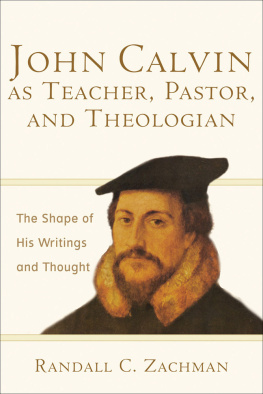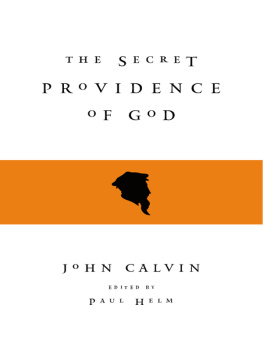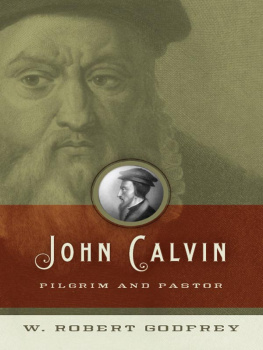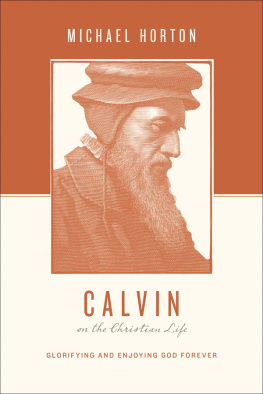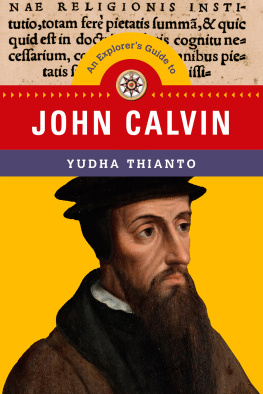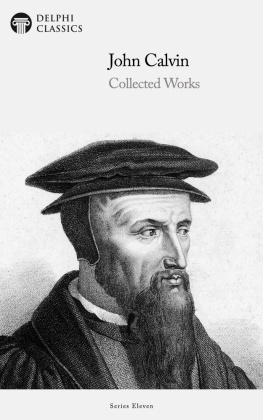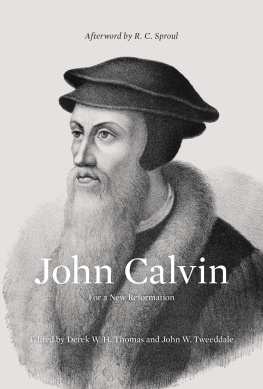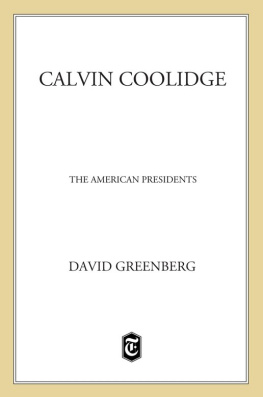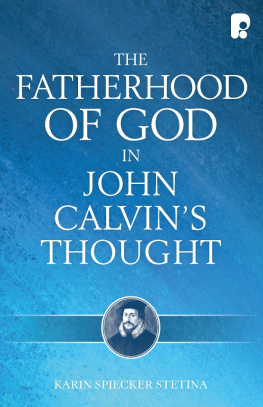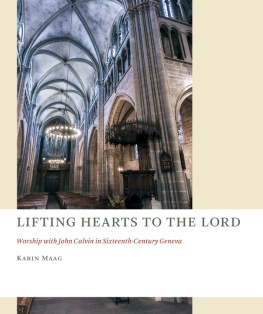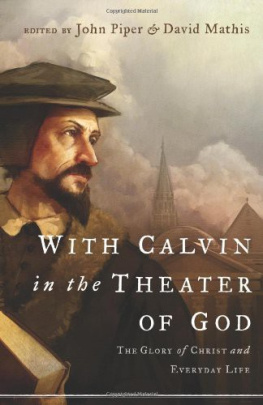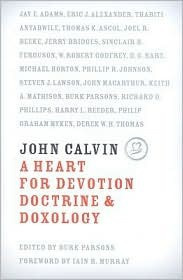
2006 by Randall C. Zachman
Published by Baker Academic
a division of Baker Publishing Group
P.O. Box 6287, Grand Rapids, MI 49516-6287
www.bakeracademic.com
Ebook edition created 2013
All rights reserved. No part of this publication may be reproduced, stored in a retrieval system, or transmitted in any form or by any meansfor example, electronic, photocopy, recordingwithout the prior written permission of the publisher. The only exception is brief quotations in printed reviews.
ISBN 978-1-4412-4192-4
Library of Congress Cataloging-in-Publication Data is on file at the Library of Congress, Washington, DC.
Scripture quotations labeled NRSV are from the New Revised Standard Version of the Bible, copyright 1989, Division of Christian Education of the National Council of the Churches of Christ in the United States of America. Used by permission. All rights reserved.
Scripture quotations labeled RSV are from the Revised Standard Version of the Bible, copyright 1952 [2nd edition, 1971] by the Division of Christian Education of the National Council of the Churches of Christ in the United States of America. Used by permission. All rights reserved.
C ONTENTS
P REFACE
This book has arisen out of two insights into the theology of John Calvin that I discovered in the course of teaching his theology for the past two decades. First, I learned that Calvin had as his ultimate objective teaching every single man, woman, and child how to read Scripture for themselves, so that they might apply its genuine meaning to every aspect of their lives. To this end, Calvin dedicated himself in his office as teacher to training orthodox and evangelical pastors who would act as guides to the interpretation of Scripture for their congregations, primarily by means of the Institutes and biblical commentaries. Calvin also acted as a pastor in Geneva, teaching the ordinary Christians in his congregation the sum of the doctrine of piety in the Catechism , and then guiding their own reading of Scripture by his exposition and application of Scripture in his sermons. Calvin envisioned the church as a school in which all Christians act as both students and teachers, under the instruction of the Holy Spirit, the author of Scripture. In this school, teachers who guide others in their reading must always be willing to be taught themselves, both by other teachers and by their students, whereas students must also be ready to teach as well as to be taught. It has been my delight to discover more of Calvins vision of the teachable teacher with my own students, who became my teachers as well. I would therefore like to dedicate the first part of this book to my students who studied Calvin together with me for the first two decades of my teaching career, as well as to the teacher, Brian A. Gerrish, who above all others taught me what to look for in Calvins theology.
Second, I discovered that for all his interest in teaching and reading Scripture, Calvin was a deeply contemplative theologian, who claimed that the invisible God becomes somewhat visible to us in what he called living images of God, which form the self-manifestation of God. Calvin exhorted the godly to contemplate these living images of God for themselves, in conjunction with their hearing and reading of Scripture, so that they might perceive, feel, and enjoy the goodness of God portrayed therein and be drawn upwards to God from the inmost affection of their hearts, being transformed themselves thereby into the image of God. Calvin pointed to two living images in particular in which the fountain and author of every good is manifested to us, the universe and Jesus Christ. As a theologian, therefore, Calvin was especially concerned to follow the analogy and anagoge between the visible self-manifestation of God and the realities manifested therein. I would like to dedicate the second part of this book to my wife Carolyne Call, for she has consistently pointed me to the living image of God in the beauty of creation and especially in the other creatures with whom we share our life on earth, and she has been for me an especially vivid image of the goodness of our Creator and Redeemer.
A BBREVIATIONS
| Calvin: Commentaries | Calvin: Commentaries, trans. and ed. Joseph Haroutunian (Philadelphia: Westminster, 1958) |
| Calvin: Theological Treatises | Calvin: Theological Treatises, ed. J. K. S. Reid (Philadelphia: Westminster, 1954) |
| CNTC | Calvins New Testament Commentaries, ed. David W. Torrance and Thomas F. Torrance, 12 vols. (Grand Rapids: Eerdmans, 195972) |
| CO | Ioannis Calvini opera quae supersunt omnia, ed. Wilhelm Baum, Edward Cunitz, and Edward Reuss, 59 vols., Corpus reformatorum 2987 (Brunsvigae: Schwetschke [Bruhn], 18631900) |
| Comm. | Commentary |
| CR | Corpus reformatorum, vols. 128, Philippi Melanthonis opera (Halis Saxonum: Schwetschke, 183460) |
| CTS | The Commentaries of John Calvin on the Old Testament, 30 vols. (Edinburgh: Calvin Translation Society, 184348) |
| Inst. and LCC | John Calvin, Institutio christianae religionis (Geneva: Rob. Stephani, 1559). Cited by book, chapter, and section, from OS 35, followed by LCC references to Calvin, Institutes of the Christian Religion, ed. John T. McNeill and trans. Ford Lewis Battles, 2 vols., Library of Christian Classics (Philadelphia: Westminster, 1960) |
| Letters | The Letters of John Calvin , trans. Jules Bonnet, 4 vols. (New York: Franklin, 1972) |
| LW | Luthers Works , ed. Jaroslav Pelikan and Helmut T. Lehmann, American edition (St. Louis: Concordia; Philadelphia: Fortress, 1955) |
| MWA | Melanchthons Werke in Auswahl , ed. Robert Stupperich (Gtersloh: Gerd Mohn, 1961) |
| OE | Ioannis Calvini opera omnia , series 2, Opera exegetica veteris et novi testamenti (Geneva: Librairie Droz, 1992) |
| OS | Ioannis Calvini opera selecta, ed. Peter Barth, Wilhelm Niesel, and Dora Scheuner, 5 vols. (Munich: Kaiser, 192652) |
| Romanos | Iohannis Calvini commentarius in epistolam Pauli ad Romanos, ed. T. H. L. Parker, Studies in the History of Christian Thought 22 (Leiden: Brill, 1981) |
| Tracts and Treatises | John Calvin, Tracts and Treatises, trans. Henry Beveridge, 3 vols. (Grand Rapids: Eerdmans, 1958) |
| WA | D. Martin Luthers Werke: Kritische Gesamtausgabe (Weimar: Bhlau, 1883) |
PART 1
C ALVIN AS T EACHER AND P ASTOR
John Calvin lived during a time when many Christians, both Roman and evangelical, recognized that the ministry of the church was in crisis. It is difficult for us to imagine what the training of ministers must have been like before seminaries were created precisely to address the lack of adequate ministerial formation during this period. John Calvin was well aware of the dire consequences of this lack of ministerial formation. According to Calvin, neither bishops nor priests were skilled in the interpretation of Scripture or particularly adept at teaching the summary of the doctrine that leads to genuine piety. Those who were regarded as the leaders of faith neither understood thy Word, nor greatly cared for it. They drove unhappy people to and fro with strange doctrines, and deluded them with I know not what follies. Ordinary Christians were turned away from Scripture to human-made images, statues, and pictures in the churches, which were understood to be the books of the unlearned. Thus, the neglect of Scripture by the ministers of the church led directly to the superstitious adoration of images, and the confinement of God to those images.
Next page
